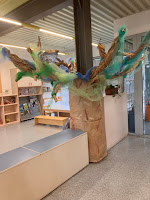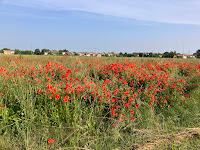Day 11: May 28
- Arlecchino Scuola Comunale d'Infanzia -- Parma
- Back at Manzoni Valeria...
- Great Find!
- References
Arlecchino Scuola Comunale d'Infanzia -- Parma
As I walked in, I could feel and see that this school was Reggio-inspired. Students were working at lit tables, artwork was displayed all over the walls, there was a reading nook that the coordinator explained was the library area, a dressing area with mirrors was in the main space, and there was a large outdoor area that had recycled materials to ornament the natural materials (including tires as small flower beds). I could immediately tell the school was aiming for a collaborative space aligned with Reggio ateliers (Malaguzzi, 1993/1994; McNally & Slutsky, 2017; Wurm, 2005). However, the setting in the classrooms were very similar, indicting the fact that the school is Reggio-inspired and not a true Reggio school.
Each of the six classrooms included multiple tables for collaborative work. Although the main area had the library, along with tables where students in different classes could paint, play with sand, or build with LEGOs together, these materials were also in each of the classrooms. The classrooms also contained toys and games, as well as a small corner where students who needed naps or independent time could decompress. What was interesting was that one of the rooms had cots for the children while another had mats and large pillows.
Some students in either one of the classrooms or in the main area were painting. One of the teachers said that the main goal was for students to experiment with mixing colors. In other rooms and in the main area students were playing with sand. They had different sized buckets and could pour it on a table covered with cloth, run it through their fingers, make patterns on the table or in the buckets, or anything else. When playing with LEGOs or wooden blocks, students also used natural items like shells, seeing how high or wide they could create a building or city. In one room, students were working with a soft modeling clay. As I waved to the group at the table, one student grabbed my hand and pulled me down to their level, then put my hands in another child's face. The second child then put clay in my hands, so I made pretend cookies and pizza with them.
Each classroom also opened up to the outside area, which was fenced in to give students a little more freedom. There were balance beams, play areas, picnic benches, and a gazebo throughout the entire area surrounding the school. Each classroom's doorway had an awning to protect students going outside from the elements, and also housed rain boots. Students were playing on the playground items, drawing in chalk, and playing tag within their designated areas.
A teacher was with every large group of students, giving them positive reinforcement, discussing their thought processes, and helping with certain skills they struggled with (like drawing lines). The other USC students and I discussed how the school was more structured than full Reggio schools, which may help prepare students for primary schools, yet allowed them to be children and play and experiment through respect and responsibility without worrying about messes and noise. Unlike Reggio schools, documentation was less stringent, which made the atmosphere feel more relaxed.
We were informed that students are told the rules of playing in groups and in different areas. Based on the group of children each year, rules may change, though students can always move freely in the classroom and can leave as long as they let the teacher know. The educators promote collaboration between the classes, especially since each class is already a mixed-age group. The start of each school year additionally provides the educators time to consider the age, spacial needs, and educational background of incoming students so that each class is balanced and equitable. Every student is fully included; if one is struggling due to special needs or other reasons, the teachers will help the child build relationships with the other students one person at a time.
I find it very interesting that the Reggio and Reggio-inspired schools have practiced what they preach regarding how community is brought into the education. Only the schools implementing the Reggio approach have provided us with food or drink. They have also been the only schools that allotted an hour-long debriefing session to help us better understand the schools and to also help them know what they may need to document in the future. I felt fully welcomed there as opposed to feeling moderately welcomed at the public schools.
Back at Manzoni Valeria...
It was nice to finally debrief at this school and learn about the five schools that Alessandra, the principal, is head of. I think it would have been helpful to have that information at the onset and then to have just a debriefing session today. Based on the observations at the middle school, I was not surprised to learn that the schools have one of the higher populations of immigrant children. There are a lot of social classes, cultures, and ethnicities represented, and a specialized intercultural inclusion teacher helps refugee and immigrant families acclimate to the school and area. There are two other specialized teachers, one for learning disabilities that require long-term educational plans and another for temporary issues where the learning plan may only be for three months based on an emotional or family issue. As Alessandra discussed the role of that specialist, I was reminded of the ASPIRE program at my school, that helps students with emotional or family issues remain in school and learn coping skills.
I had noted in an earlier entry that the technology teacher said that sometimes he talks with the math and science teachers, but didn't have much time to collaborate. Alessandra clarified on this by saying that middle school teachers are only required to work 18 hours in a week. While I can say the same, where I teach 18-20 hours a week, I am still required to stay in the school building for 35-40 hours a week. Alessandra said that the 18-hour requirement along with the trade union makes it very difficult to have mandatory time for teachers to collaborate and develop cross-disciplinary assignments and projects.
Great Find!
I think that the part of the day that made me smile most was what I found in the comic store. I was hoping to see Dark One by Brandon Sanderson but I found something even better—volumes 2-4 of Dark Ark trades by Aftershock comics, where my brother used to be an editor. They’re an indie company and it was so cool to find the books in Italian! Yes, I bought volume 2.
References
Malaguzzi, L. (1994). Your image of the child: Where teaching begins. (B. Rankin, L. Morrow, & L. Gandini, Trans.). Child Care Information Exchange, 96, 52-61. (Original work published 1993, June).
McNally, S. A., & Slutsky, R. (2017). Key elements of the Reggio Emilia approach and how they are interconnected to create the highly regarded system of early childhood education. Early Child Development and Care, 187(12), 1925-1937. https://doi.org/10.1080/03004430.2016.1197920
Wurm, J. (2005). Working in the Reggio way: A beginner’s guide for American teachers. Redleaf Press.









Comments
Post a Comment